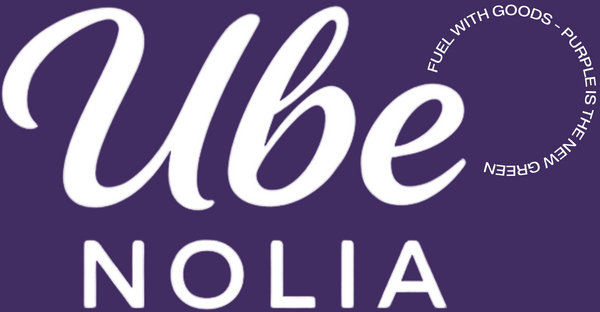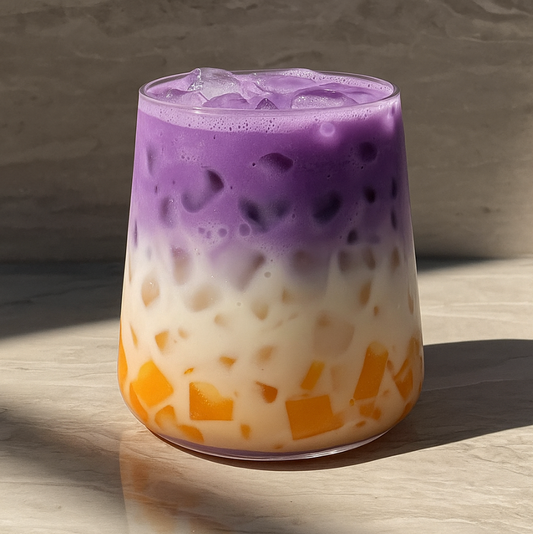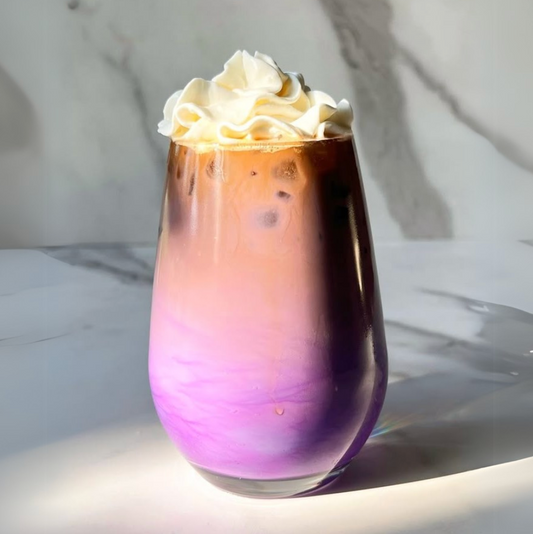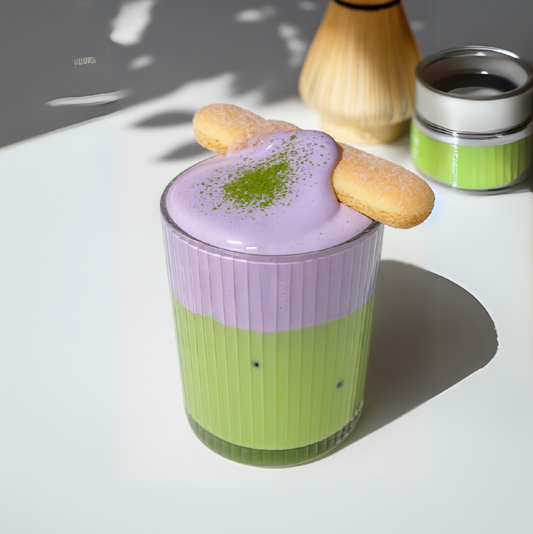🇪🇺 EU (Europe)
Ube: All About Ube Powder & Where to Buy It
Ube—also called purple yam—has become a sought-after ingredient for its vivid purple color, gentle sweetness, and uses in lattes, pastry, desserts, ice cream, creams, and cookies. This complete guide explains how to buy ube powder wisely, use it daily, and avoid common pitfalls.
See also: Which brand offers the best Ube?

Buying ube powder: what is ube and why the hype?
Ube (Dioscorea alata) is a tropical root widely used in the Philippines. As ube powder, it’s convenient, stable, and easy to dose. Its subtle flavor hints at vanilla, hazelnut, and sometimes almond, without bitterness when properly processed—perfect for striking drinks and pastries with a delicate, non-artificial taste.
Origin, processing & quality control
Fresh roots are selected, cleaned, gently dried, and micronized into a fine powder. To buy ube powder with confidence, look for clear traceability (origin, lot, tests) and a regular texture that dissolves well in milk, oat, or soy and blends smoothly into pastry creams.
Benefits—what matters
Without making health claims: ube naturally contains anthocyanins (purple pigments), fiber, and complex carbs. As a powder, it’s easy to dose, store, and standardize—consistent flavor, color, and texture batch after batch.
Antioxidants (anthocyanins)
They provide the purple hue and valued antioxidant properties. When you buy ube powder, check that the color stays stable after mixing or baking—good sign of controlled processing.
Fiber & mouthfeel
A fine powder integrates into creams, desserts, and ice cream for a silky result—no chalkiness, no artificial notes.
How to use ube powder (kitchen & pastry)
Ube is highly versatile. In hot or iced drinks it pairs with milk and plant milks (oat, soy, almond) and supports light syrup/sugar bases without overpowering. In pastry, it gently colors and perfumes with a premium showcase look.
Sweet ideas: lattes, ice cream, creams, cookies & desserts
Ube latte (2.5 g/250 ml + 10–15 ml neutral syrup), ice creams and creams (1–2% of base), cookies/cakes (1–2% of flour), glass desserts (panna cotta, mousses). Avoid overly sweet formulas that mask natural aromas (vanilla/hazelnut/almond) or create bitterness.
Savory applications
In small amounts, ube adds visual appeal to purées or sauces. If you buy ube powder mainly for savory, start with low dosages so the main ingredient still leads.
Choosing a premium powder (buyer’s guide)
To buy ube powder smartly, identify a pure, consistent, compliant powder. Check these points:
Purity & composition
Best choice: 100% ube powder—no added sugar, no additives, no artificial flavor. “Flavored” or “sweetened” mixes skew dosing and cost per serving and reduce the finesse of natural aromas.
Testing & traceability
Prefer sellers sharing lot numbers, origin, compliance info, and pesticide/microbiology tests—key for resale in grocery/fine food contexts.
Color, grind & solubility
Premium powder shows a clean purple tone, fine grind, and even solubility (milk/oat/soy). Test quickly in a drink and a cream for stability.
Where to buy in France (shops & online)
You can buy ube powder in Asian grocers, fine food stores, or online. For 100% pure powder, no additives/artificial flavors, with pesticide tests and clear traceability, the safest option is the official Ube Nolia website. We meet quality/compliance criteria, offer sachets to try and bulk to produce, with 24h shipping from EU stock (Spain) and COA/TDS per lot.
Grocery & fine food: instant buy, limited choice
Pro: walk out with a sachet to try an ube latte, desserts, or pastry. Cons: limited stock, sometimes incomplete info on purity/traceability/pesticide tests. Handy for a first try; for premium consistency, choose a vendor that documents lots.
Buying online: traceability, formats & service
Online you can compare composition (100% ube, no additives), origin, and formats (sachets 80–100 g, 1 kg / bulk 5–25 kg). On ube-nolia.com, each lot has useful info (COA/TDS, usage tips); expected aromas (vanilla, hazelnut, almond) are respected; logistics is fast (ships in 24h). Most reliable path to buy ube powder for stable color and performance in ice cream, creams, cookies, and lattes.
Why buy from Ube Nolia (the reference)
- Controlled purity: 100% ube, no additives, no artificial flavor; clean taste, no bitterness.
- Traceability & compliance: COA/TDS per lot, pesticide panel, clear Philippine origin.
- Right formats: sachets to test/retail; bulk for kitchens and labs (optimized cost/serving).
- Recipe performance: stable purple color, good solubility (milk/oat/soy), natural aromas respected.
- EU logistics: ships within 24h from Spain; responsive support.
🇪🇺 EU (Europe)
Buying ube powder: price, formats (sachets, bulk) & storage
Pick the format by use case. For home, a sachet (80–100 g) is enough to test several recipes. For kitchens/coffee shops, go bulk (1–10 kg) to optimize cost per serving and standardize recipes.
Formats & cost per serving
A typical ube latte uses ~2–3 g powder; a cream, ice cream, or cookie base often uses 1–2% of total weight. Calculate portion cost before buying large quantities.
Storage & BBE (best-before date)
Store away from heat, humidity, and light in an airtight container. Respect the BBE and note the opening date of the sachet. This preserves color, solubility, and aroma profile.
Compare sellers (useful checklist)
- Composition: 100% ube; no additives, no artificial flavor.
- Testing: pesticide/microbiology panel per lot.
- Traceability: clear origin, lot number, compliance info.
- Formats: sachets to try; bulk to produce.
- Sensory quality: no bitterness, natural aromas (vanilla/hazelnut/almond), stable color.
- Service: detailed info, usage tips, reliable shipping.
Usage tips & mistakes to avoid
Dosing & solubility
Start low (2 g for a latte, 1–2% in pastry) then adjust. Dissolve hot for drinks or pre-slurry with a little liquid. With plant milks (soy, almond, oat) whisk well for even color/texture.
Sweetness balance & aroma respect
A light syrup supports flavor without covering it. Avoid overly sweet recipes or strong artificial flavors that mask ube’s character.
Baking & color
Mix the powder evenly; test small batches to validate color after baking/chilling. For ice creams and creams, allow cold maturation to stabilize tone and texture.
FAQ
Difference between ube powder and “ube flavor”?
Ube powder comes from the root; a flavor can be natural or synthetic—often stronger but less authentic. Prefer 100% ube with no additives/artificial flavors.
Can I use ube powder in plant milks?
Yes—great with oat, almond, and soy. Adjust dose and syrup so aromas remain clear.
What to check before buying for resale?
Traceability (lot, origin), pesticide/microbio tests, 100% composition, well-labeled sachets, and a bulk option for volume pricing.
Is ube powder naturally sweet?
100% ube powder has no added sugar. It contains naturally occurring sugars in moderate amounts; you perceive mostly an aromatic sweetness (vanilla/hazelnut/almond). For a balanced latte: 2.5 g per 250 ml + 10–15 ml syrup.
In short
Choose 100% ube with documentation, no additives or artificial flavors, and consistent results. Pick the right format (sachet to test; bulk to produce), mind dosing/solubility, and keep recipes balanced to showcase natural aromas.
- buy ube powder
- ube powder
- purple yam
- ube latte
- ube pastry
- grocery & fine food
- sachets & bulk
- vanilla hazelnut almond aromas
- syrup & sweet recipes
- no artificial additives
- pesticide tests & traceability
Get it now to make delicious recipes: lattes, cakes, bread…












